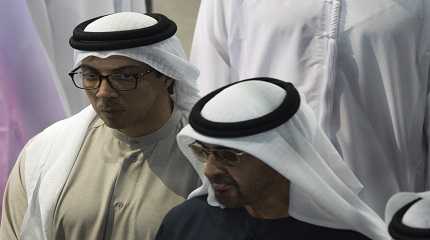
DUBAI, United Arab Emirates (AP) — The leader of the United Arab Emirates toured the Dubai Air Show on Wednesday as a sanctioned Russian arms supplier displayed an attack helicopter used in its war on Ukraine, highlighting his country’s continued ties to Moscow despite Western sanctions targeting it.
Sheikh Mohammed bin Zayed Al Nahyan toured the show with his brother, Sheikh Mansour bin Zayed Al Nahyan, a vice president and deputy prime minister of this autocratic country of seven sheikhdoms.
They stopped by a stand for EDGE, an Emirati defense company, where Sheikh Mohammed signed a drone in front of onlookers before attending a meeting there.
Outstanding on the runway, Russian pilots sat inside a KA-52 attack helicopter as it was pulled down the runway at Al Maktoum International Airport. Those helicopters have been repeatedly used in Ukraine and its manufacturer, Russian Helicopters, is sanctioned by the U.S. Treasury.
Inside a Russian pavilion on the runway, far away from the indoor stands of other airlines and suppliers, onlookers picked up and racked an AK-19 assault rifle on display. Others look at miniature drones and other equipment used by Moscow. Russian pilots associated with the manufacturer walked the halls of the inside displays in their flight suits.
Staff on hand at the pavilion referred questions to a spokesperson who did not respond to a request for comment by The Associated Press. The U.S. Embassy in Abu Dhabi referred questions to Washington, which did not immediately respond to queries. The U.S. military also has a HIMARS missile system, the type used with great success by Ukraine, on display at the opposite end of the runway at the show.
Russia had a similar display at the International Defense Exhibition and Conference in February that did not include attack aircraft. Russian money continues to flood into Dubai’s red-hot real estate market, in part by some who have fled Moscow over the war.
Daily flights between the Emirates and Moscow provide a lifeline for both those fleeing conscription and the Russian elite. The U.S. Treasury has expressed concerns about the amount of Russian cash flowing into the Arabian Peninsula country.
Meanwhile Wednesday, passenger numbers at Dubai International Airport this year will eclipse the passenger figures for 2019, showing the strong rebound in travel after the coronavirus pandemic and lockdowns that grounded aircraft worldwide, a top official said.
The airport, the world’s busiest for international travel and home of the long-haul carrier Emirates, has had 64.5 million passengers pass through its cavernous concourses through the third quarter of this year. That puts it on track to reach 86.8 million passengers for the full year, which would exceed its 2019 figure of 86.3 million passengers. It had 66 million passengers last year.
The airport’s busiest year was 2018, when it had 89.1 million passengers.
“So for the end of the year, current predictions, 86.8 million, a little bit shy of the pre-pandemic numbers,” Paul Griffiths, Dubai Airports CEO, told The Associated Press in an interview at the Dubai Air Show. “But actually, hopefully, by the end of the year, we may be able to raise that forecast.”
He added: “I think now because we’ve got the full network with 250 destinations, 95 airlines and 105 countries, that’s why we’ve been able to recover so strongly.”
Hartsfield-Jackson Atlanta International Airport remains the busiest passenger airport overall.
Through the third quarter, Dubai’s main airport handled 308,000 total takeoffs and landings. India, long a key route for Emirates’ East-West travel strategy, led all countries in destinations, followed by Saudi Arabia, Pakistan, the U.S. and Russia. Emirates and other airlines in the United Arab Emirates, an autocratic federation of seven sheikhdoms, have continued to fly to Moscow even during Russia’s war on Ukraine.
Israel’s war on Hamas in the Gaza Strip also has slowed traffic to and from Ben Gurion International Airport in Tel Aviv for Dubai, which established direct flights after the UAE diplomatically recognized the country in 2020. Numbers also remain lower with flights from China, which used to be a major source market for Emirates and Dubai’s tourism industry.
“Because we have such a diversified network across so many different countries, we’ve got pretty strong demands. And when we have one or two traffic flows which go down, it’s always compensated by something that recovers more strongly,” Griffiths said. “For example, the Far East, we’re still seeing traffic from China in very low numbers. But as that resurges, I’m absolutely sure the numbers will be boosted by that.”
Griffiths’ announcement comes during the Dubai Air Show at Al Maktoum International Airport at Dubai World Central, the city-state’s second airfield some 45 kilometers (28 miles) away from Dubai International Airport. While used by commercial airlines when Qatar hosted the 2022 FIFA World Cup, the second airport that opened in 2010 largely sees cargo and private aircraft flights.
During this year’s show, Emirates has announced a $52 billion aircraft purchase with Boeing Co., while its sister airline FlyDubai bought another $11 billion of aircraft from Boeing. Airbus on Wednesday announced the sale of 11 additional A350-900s to Ethiopian Airlines, though the European manufacturer has yet to announce a major sale at the show.
“This, I think, has been the greatest air show of all time,” Griffiths said. “The mood is great. The confidence is great. The quality of the show is great. I think the outlook for aviation here in Dubai has never been brighter.”




